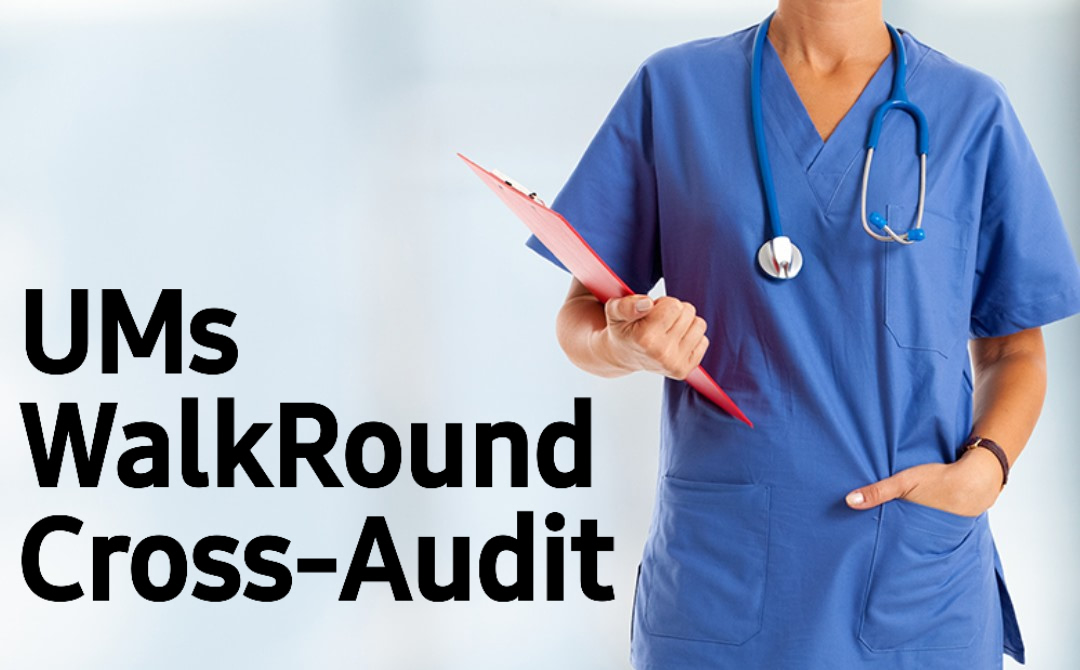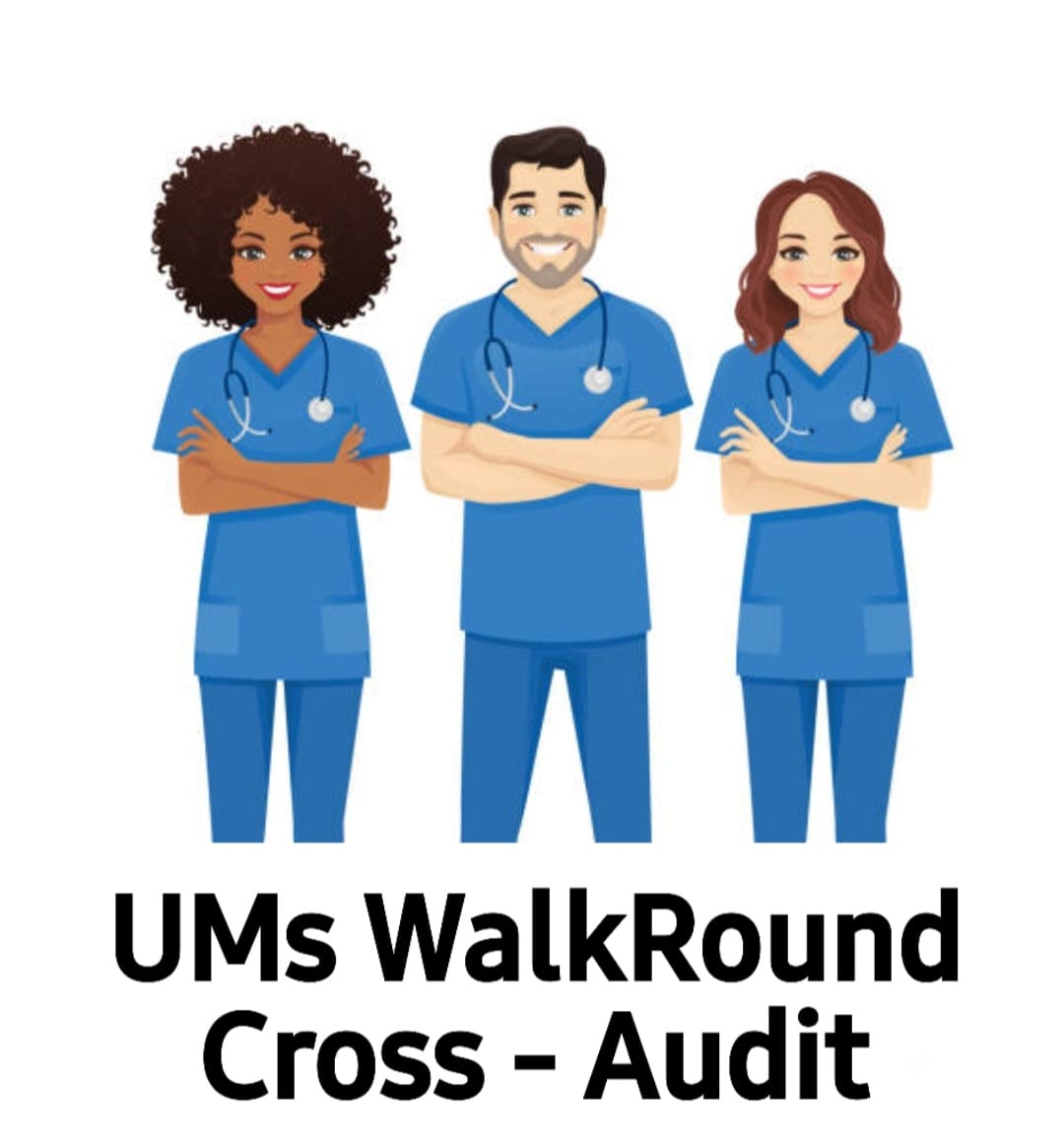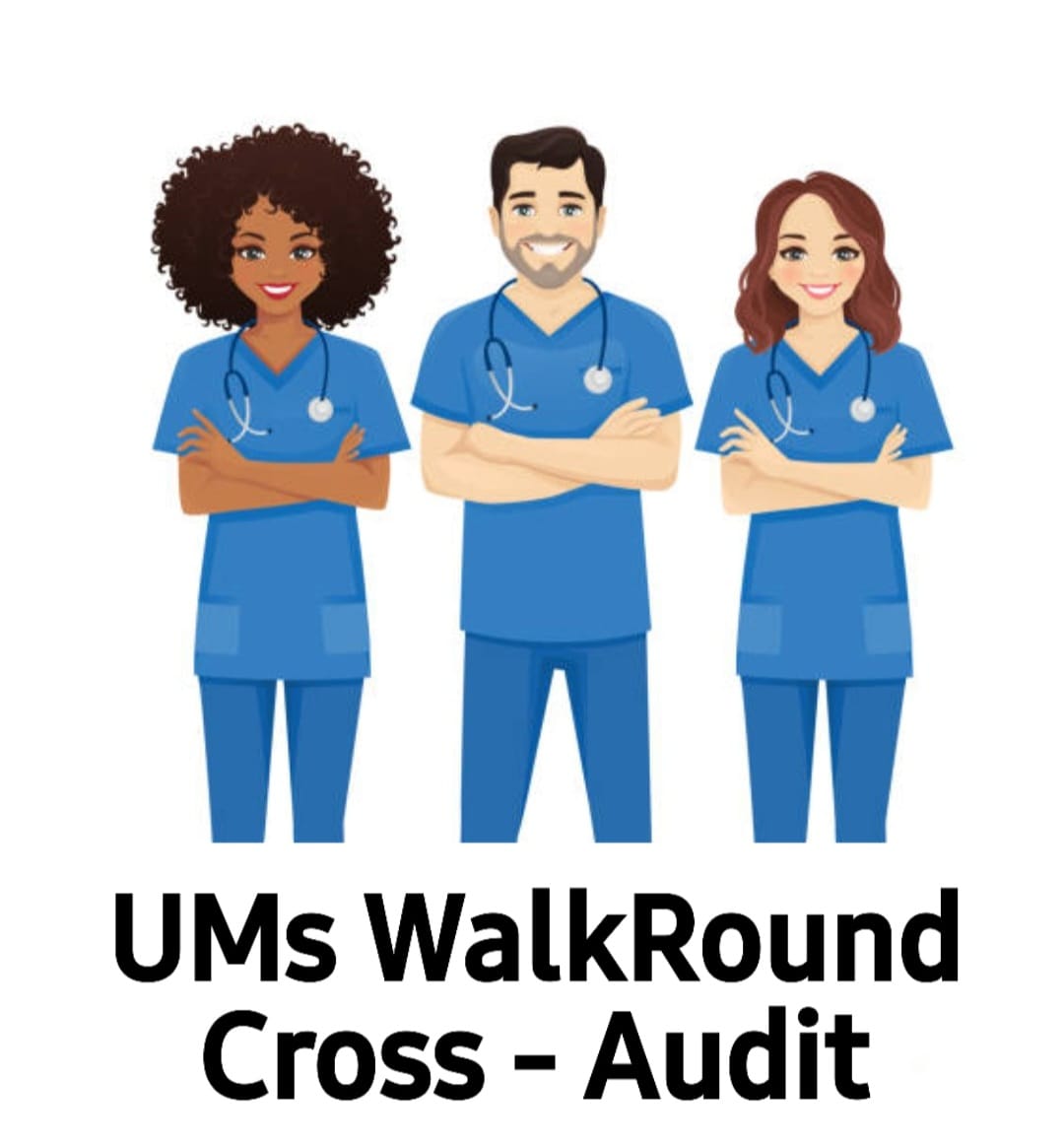Title Page
-
Site conducted
-
Conducted on
-
Prepared by
-
Location
UM WalkRounds Cross Audit - General Standards
NURSING (3 standards, 2 sub-standards and 17 sub-points)
-
NR.4 Nursing reference manuals and policies are readily available and accessible to all nursing units [How to locate Regulatory Document (policies and procedures)in the intranet)] (Observation & Staff Interview)
-
NR.6 Sufficient nurses are available to meet the needs of patients. (Observation)
NR.12.1 The nursing department ensures the availability of equipment and supplies necessary for the safe and effective provision of care. This includes, but is not limited to, the following: (Observation)
-
NR.12.1.1 Scales appropriate to the age group and mobility needs of the patient
-
NR.12.1.2 Stretchers with safety straps
-
NR.12.1.3 Equipment for taking vital signs
-
NR.12.1.4 Wheelchairs with safety straps
-
NR.12.1.5 Sharp boxes
-
NR.12.1.6 Foot stools
-
NR.12.1.7 Lifting devices
-
NR.12.1.8 Soft restraints
-
NR.12.1.9 Bed rails
-
NR.12.1.10 Devices for treatment and prevention of skin breakdown
-
NR.12.1.11 Patient call bell
-
NR.12.1.12 Oxygen and suction
-
NR.12.1.13 Glucometer
-
NR.12.1.14 Nebulizers
-
NR.12.1.15 Blood warmers
-
NR.12.1.16 ECG machines
-
NR.12.2 The Nursing department has a process to maintain adequate supplies and linen to meet patient needs. (Observation)
-
NR.12.2.1 Critical levels are identified. (Observation)
INFECTION PREVENTION & CONTROL (IPC) – (11 standards and 5 sub-standards)
-
IPC.13 Sharps are discarded in appropriate containers. (Observation)
-
IPC.15 Facility design and available supplies support isolation practices. ESR (Observation)
-
IPC.24.1 Hospital environment, lockers, and cabinets are clean. (Observation)
-
IPC.24.2 Food is stored under sanitary conditions and is consumed in designated places. (Observation)
-
IPC.24.3 Food refrigerators are clean and are used only for food storage. (Observation)
-
IPC.24.4 There are separate clean and dirty utility areas in each patient care area. (Observation)
-
IPC.25 There is a system to handle blood/body fluids spills (Observation)
-
IPC.26 The hospital implements a program that is consistent with laws and regulations for safe disposal of medical waste. (Observation)
-
IPC.32.1 Personal protective equipment (gown, gloves, masks, and protective eyewear) are readily available in all patient care areas. (Observation)
-
IPC.33 The hospital supports appropriate hand hygiene practices. (Observation)
-
IPC.34 The hospital provides sufficient hand hygiene facilities. (Observation)
-
IPC.39 The hospital implements evidence-based interventions to prevent ventilator–associated pneumonia. (Staff Interview)
-
IPC.40 The hospital implements evidence-based interventions to prevent surgical site infection. (Staff Interview)
-
IPC.41 The hospital implements evidence-based interventions to prevent catheterassociated urinary tract infection. (Staff Interview)
FACILITY MANAGEMENT & SAFETY (12 standards, 20 sub-standards and 32 sub-points )
-
FMS.6 Warning and directive signs are posted inside the hospital as appropriate. (Observation)
-
FMS.6.1.1 Signs for the radioactive materials including warning signs for pregnant women
-
FMS.6.1.2 Signs for wet floors during cleaning
-
FMS.6.1.3 No smoking signs
-
FMS.6.1.4 Signs and warning lights for x-ray room(s)
-
FMS.6.1.5 Signs to restrict cellular phones in sensitive areas as appropriate, e.g., MRI or critical care units
FMS.6.2 There are directive signs posted as appropriate in the hospital and include:
-
FMS.6.2.1 Signs indicating the hospital name and main entrances/exits
-
FMS.6.2.2 Directional signs
-
FMS.6.2.3 Signs to direct staff and patients to the different services in the hospital
-
FMS.6.2.4 Fire exit signs
-
FMS.6.2.5 Signs to identify floor level at staircases and in front of elevators
-
FMS.6.2.6 Signs to instruct staff, patients, and visitors in restricted areas
-
FMS.6.2.7 MRI patient safety measures and steel restriction signs
-
FMS.6.2.8 Signs for populations with special needs
FMS.8.1 The patients’ bathrooms and showers are provided with the following safety measures: (Observation)FMS.8.1 The patients’ bathrooms and showers are provided with the following safety measures: (Observation)
-
FMS.8.1.1 non-slipping floors’ surfaces
-
FMS.8.1.2 Bars to support patients
-
FMS.8.1.3 Bell or a system to call for help
-
FMS.8.1.4 Lock system that allows opening from outside
-
FMS.9 The hospital ensures that all its occupants are safe from radiation hazards. ESR (Observation)
-
FMS.10 Patients and staff are protected from unnecessary exposure to laser beams in areas where it is used. Observation
-
FMS.14.3 Each department dealing with hazardous materials has Material Safety Data Sheets (MSDS) relevant to its current list of hazardous materials. (Staff Interview & Observation)
-
FMS.14.4 Each department using hazardous materials has proper personal protective equipment (PPE) and spill kits to handle any spill or exposure. (Observation)
-
FMS.20 Fire extinguishers are available in the hospital and are properly distributed. (Observation)
-
FMS.20 Fire extinguishers are available in the hospital and are properly distributed. (Observation)
-
FMS.23 There are fire exits that are properly located in the hospital. (Staff Interview & Observation)
-
FMS.24.1 The hospital implements a strict “No Smoking” policy. (Observation)
-
FMS.24.2 There are no obstructions to exits, fire extinguishers, fire alarm boxes, emergency blankets, safety showers, and eye wash stations. (Observation)
-
FMS.24.4 Storage areas are properly and safely organized: (Observation)
-
FMS.24.4.1 Shelves and racks are sturdy and in good condition
-
FMS.24.4.2 No items stored directly on the floor (a minimum of ten centimeters is left to manage spills)
-
FMS.24.4.3 Items should be stacked on a flat base
-
FMS.24.4.4 Heavier objects are close to the floor and lighter/smaller objects are higher
-
FMS.24.4.5 Items are not stacked so high to block sprinklers or come in contact with overhead lights or pipes (a minimum distance of fifty centimeters from ceiling level)
FMS.31 The hospital ensures that emergency power covers the critical areas in case of failure
-
FMS.31.1 The hospital has an emergency power that covers at least the following critical areas: (Observation)
-
FMS.31.1.1 Operating room
-
FMS.31.1.2 Labor and delivery
-
FMS.31.1.3 Critical care units
-
FMS.31.1.4 Alarm system
-
FMS.31.1.5 Fire pumps
-
FMS.31.1.12 Medications stores
-
FMS.31.1.13 Emergency room
FMS.32 The hospital ensures proper maintenance of the medical gas system. ESR (Staff Interview & Observation)
FMS.32.1 The medical gas system is regularly tested for:
-
FMS.32.1.1 Pressure
-
FMS.32.1.2 Leaks
-
FMS.32.1.3 Functionality of valves, alarms, pressure gauge, and switches
FMS.35 The hospital ensures proper air flows (positive, negative, balanced) in the required locations. (Observation)
-
FMS.35.1 operating room(s)
-
FMS.35.2 labor and delivery
-
FMS.35.3 isolation room(s)
-
FMS.35.4 critical care unit(s)
-
FMS.35.5 clean and dirty utility
-
FMS.35.6 janitorial closet
-
FMS.35.8 triage and trauma management areas
FMS.36.5 Temperature and humidity are controlled and regularly monitored inpatient rooms. (Observation)
-
FMS.36.1 operating and recovery room(s)
-
FMS.36.2 nursery
-
FMS.36.3 critical care unit(s)
-
FMS.36.5 inpatient rooms
MEDICATION MANAGEMENT (14 standards and 1 sub-standard)
-
MM.5 The hospital has a system for the safety of high-alert medications. ESR (Staff Interview & Observation)
-
MM.6 The hospital has a system for the safety of look-alike and sound-alike (LASA) medications. ESR (Staff Interview & Observation)
-
MM.8.3 The hospital formulary is accessible to all those involved in medication management. (Staff Interview & Observation)
-
MM.11 The hospital has a safe and secure system for the storage of regular medications and nutrition products in stores, pharmacies, and patient care areas. (Observation)
-
MM.12 The hospital has a safe and secure system for storage of refrigerated and frozen medications, biologicals, and vaccines in stores, pharmacies, and patient care areas (Observation)
-
MM.13 The hospital has a safe and secure system for the storage and safe management of hazardous medications and pharmaceutical chemicals (Observation)
-
MM.14 The hospital has a system for ensuring stability of medications available in multi-dose containers. (Observation)
-
MM.15 The hospital has a system for ensuring accessibility, availability, monitoring, and security of emergency medications (Observation)
-
MM.16 The hospital has a safe and secure system for managing medications in the patient care areas. (Observation)
-
MM.18 There is a system for storing narcotics, psychotropic and other controlled medications in accordance with relevant laws and regulations. (Observation)
-
MM.32 The hospital has a system for labeling medications (Tallman Lettering) (Observation)
-
MM.40 The hospital has a process for detecting, managing and reporting adverse drug reactions (ADRs). (Staff Interview)
-
MM.41 The hospital has a process for monitoring, identifying, and reporting significant medication errors, including near misses, hazardous conditions, and at-risk behaviors that have the potential to cause patient harm. ESR (Staff Interview)
-
IPSG 3.2 The hospital develops and implements a process to manage the safe use of concentrated electrolytes (Observation)
QUALITY MANAGEMENT & PATIENT SAFETY (6 standards and 2 sub-standards)
-
QM.10.4 Information is communicated to the appropriate stakeholders in a way they can understand and use. (Staff must be aware of their unit an hospital KPIs) (Staff Interview)
-
QM.14 The hospital has an incident (occurrence/variance) management mechanism that supports improvements of care processes. (KFMC = Datix) (Staff Interview)
-
QM.15 The hospital has a process to handle sentinel events Staff Interview
-
QM.17 The hospital has a process to ensure correct identification of patients. ESR (Observation)
-
QM.18 The hospital has a process to prevent wrong patient, wrong site, and wrong surgery/procedure. ESR (Observation)
-
QM.19 The hospital ensures availability and safety of infusion pumps
-
QM.19.2 Infusion pumps have "free-flow" protection. (Staff Interview)
PROVISION OF CARE (2 standards)
-
PC.25 Policies and procedures guide the handling, use, and administration of blood and blood products. ESR (Observation)
-
PC.30 Restraints are applied safely and in accordance with professional standards and applicable laws and regulations. (Observation)
PATIENT & FAMILY RIGHTS (4 standards and 1 sub-standard)
-
PFR.1.6 The hospital ensures that patients are informed about their rights and responsibilities. (displayed/ posted in patients’ room, nursing station, etc.) (Observation)
-
PFR.3 Privacy of patients is maintained throughout the care process. (Observation)
-
PFR.4 The hospital protects patient belongings. (Observation)
-
PFR.17 Hospital leaders develop and adopt ethical standards in dealing with patients and their supporters and sponsors. (Staff knowledge on ethical dilemma workflow in KFMC) (Staff Interview)
MANAGEMENT OF INFORMATION (1 standard and 1 sub-standard)
-
MOI.9 The hospital maintains sufficient provisions that ensure the operation of the information system during scheduled or unscheduled(unexpected) downtime
-
MOI 9.1 There are procedures and forms to be used during scheduled or unscheduled downtime (Staff Interview)









